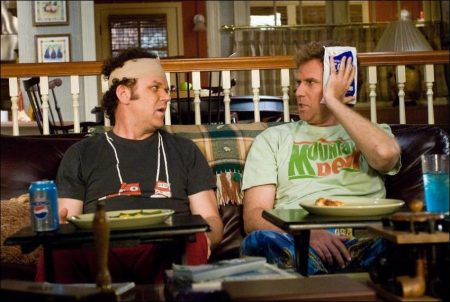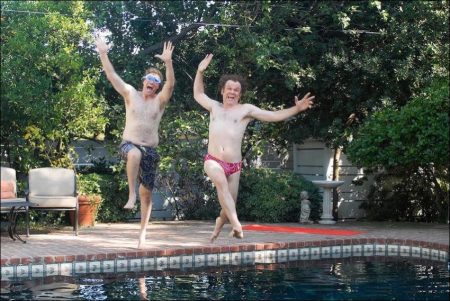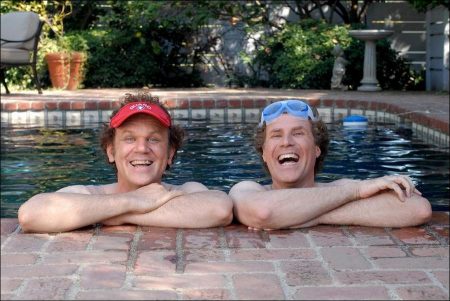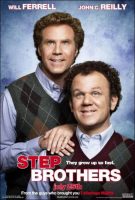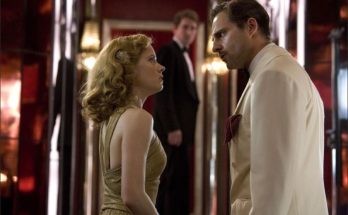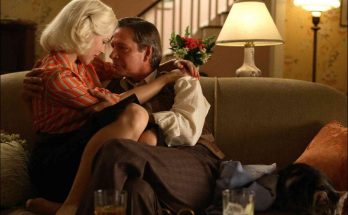Tagline: The grow up so fast.
Brennan Huff (Will Ferrell) and Dale Doback (John C. Reilly) have one thing in common: they are both lazy, unemployed leeches who still live with their parents. When Brennan’s mother and Dale’s father marry and move in together, it turns the overgrown boys’ world upside down. Their insane rivalry and narcissism pull the new family apart, forcing them to work together to reunite their parents.
Will Ferrell and John C. Reilly will play coddled guys who live with their respective single parents. Their folks fall in love and marry, making the guys stepbrothers. From the team that brought you “Talladega Nights: The Ballad of Ricky Bobby” and “Anchorman: The Legend of Ron Burgundy.”
When Robert and Nancy marry and move in together, Brennan and Dale are forced to live with each other as step brothers. As their narcissism and downright aggressive laziness threaten to tear the family apart, these two middle-aged, immature, overgrown boys will orchestrate an insane, elaborate plan to bring their parents back together. To pull it off, they must form an unlikely bond that maybe, just maybe, will finally get them out of the house.
Putting the Fun in Dysfunctional
Will Ferrell, the star of Columbia Pictures’ comedy Step Brothers, sums up the central characters by describing two grown men in a state of arrested development. “Dale and Brennan never outgrew their adolescent ideas about what’s cool, how they’d spend their time when they grew up, what they found entertaining. It was a lot of fun to explore that, thinking, ‘What if you actually became, at 40, the guy you thought you’d be when you were 13?'”
Step Brothers re-teams Ferrell with John C. Reilly and writer-director Adam McKay after the trio’s successful collaboration on the hit comedy Talladega Nights: The Ballad of Ricky Bobby. Immediately after wrapping photography on that film, Ferrell, McKay, and Reilly decided that the experience was so creatively satisfying that they wanted to repeat it. “We sat down, had dinner, and spit-balled all these ideas,” Ferrell remembers.
“When we worked on Talladega, the funniest scenes were the ones that were loose — like the ‘Baby Jesus grace’ at the dinner table,” says McKay. “That scene didn’t have a lot of story directive — it was just about meeting the characters and establishing the tone. It was important to us to find an idea that, like Talladega, was loose enough but also had enough of an engine to drive the story along.”
At the dinner, Ferrell, McKay, and Reilly came up with “pages and pages of ideas, all pretty solid, but all a little restrictive,” says McKay. Then, the next day, as he was trying to come up with the perfect idea. “Someone mentioned bunk beds for their kids and I thought, ‘I got it.’ Two grown guys, still living at home, their single parents get married, and they have to share a room.”
“As soon as we heard the idea, we immediately went for it,” Reilly adds. “Imagine if your kids just never really matured and never left the house. I mean, I love my kids, but I really hope they grow up and move out eventually.”
“What do you do if your kids are a mess?” asks producer Judd Apatow. “Richard Jenkins and Mary Steenburgen play the parents, and what’s funny about their fights in the movie is that they really just don’t know what to do. Interestingly, it’s a pretty common problem: how do you get your kids out of the house?”
“Brennan and Dale are very leery of each other. Neither of them likes the new situation at all,” Ferrell says. “All that changes when Dale meets Brennan’s younger brother Derek, who comes to dinner one night with his family. Derek is the complete opposite of Brennan. He’s successful, handsome, and has everything going for him. He’s also tormented Brennan his entire life. Dale comes to Brennan’s defense by sucker-punching Derek, and from that moment on, Dale and Brennan are best friends.”
Reilly explains his character’s unique brand of self-centeredness: “Dale is an extreme case of arrested development. His dad’s a doctor, so he’s never really had to work for anything. He’s just into the things that he likes and everything else doesn’t interest him at all. He’s into the drums, sling shots, karate, and fireworks. He’s a guy who already feels like he’s got the greatest life ever.”
Still, although they’d be playing the “kids,” Ferrell found that the movie’s central conflict was in two other characters. “When we started writing, we came up with crazy scenarios from every kind of brotherly fight we could think of and any adolescent scenario that made us laugh,” Ferrell says. “But as we continued, we really started identifying with the parents.”
McKay says that when he and Ferrell sit down to write together, the first step is often improvisation. “It’s like we’re on stage doing it — he’s a character, and I’m a character, and we’re flipping back and forth who plays each part,” says the writer-director. “The entire goal is to come up with something that makes the other person laugh. We take turns, tossing out ideas — I’ll lie on the floor, saying anything that comes to mind, and Will types. He’ll make sense of it all and then we’ll flip it — I’ll rewrite the scenes and he’ll take the job of sitting on the couch throwing out insane ideas.”
“I’ve known Adam for about 12 years now,” says Ferrell. “We were both hired at ‘Saturday Night Live’ at the same time. He had a long career as an improviser and a stage performer before he become solely a writer, and I think that influenced his directing style. It allows for a lot of freedom.”
“I like working with Will and Adam because they are truly two of the nicest guys in the industry,” says producer Judd Apatow. “They’re really funny, they really enjoy making movies, they make each other laugh, and they make the set a really happy place. In fact, when I’m directing a movie and something comes up, I think, ‘What would Adam McKay do?'”
As they wrote, Ferrell and McKay tried to ensure that characters that seemed similar on the surface had differences between them that the actors could explore. “John would play Dale, and he would be more of a planner with a ‘business mind’ — even though he has terrible ideas,” Ferrell jokes. “He’s the one with the drive and initiative, such as it is. Brennan was going to be a little more sensitive, a little more soft-spoken. And he thought of himself as a beautiful singer, but of course has a terrible fear of singing in public.
“From there, we followed those guidelines to build the characters and to write the scenes appropriately, in terms of what these characters would say and do, even though they cross over at times,” Ferrell continues. “I love that about the characters and the movie. Brennan becomes the leader at times and Dale’s the follower. I think that makes it so much more interesting.”
When the script was completed, Ferrell and Reilly started the work of shaping the performances that would bring the characters to life. “I would go home, watching my kids react to not getting something they wanted, or a petty grievance between siblings, and that stuff definitely informed my character,” says Reilly. “In that way, even though it’s an R-rated movie and we get into adult situations, the movie has a lot of innocence and joy to it.”
“With these characters, there’s a fine line between them complementing each other and enabling each other,” adds McKay. “They really should never have met each other — but somehow it works out.”
With the freedom to explore their roles, however, came a responsibility. “There were no easy days on this movie,” says Reilly. “You might start your day thinking, ‘Oh, I just have two lines in this scene, I’m just walking through,’ and hours later you’ll find that your role in the scene has been expanded. You always have to come to the set fully prepared.”
Reilly says that though he’s best known as a dramatic actor who has lately performed in comedy roles, for him, there’s been no change in focus. “It’s still the same kind of work,” he says. “It doesn’t feel all that different to me; it’s just the way the circumstances in the scenes change that make it absurd.”
“John and Will have incredible chemistry,” says Apatow. “I don’t know where it comes from, but they’re really fun to watch together and there’s something about their comedic styles that really balance each other out. They’re like a great comedy team.”
We Are Family
Though Ferrell and Reilly’s characters were already in place, it was key that the filmmakers find believable parents for Dale and Brennan. After all, it is the parents who serve as the guides into Dale and Brennan’s world.
Mary Steenburgen takes on the role of Nancy Huff. Ferrell was thrilled to be re-teaming with the Academy Award winner after collaborating on the hit holiday comedy Elf. “I played his step-mom in Elf,” Steenburgen says. “We’re trying every variation of me being Will’s mother. This time, I’m his birth mother. It was an amazing experience that was just so much fun. The hardest part of this job is to get through a take without the giggles.”
Ferrell comments: “In Elf, my character was just visiting their world, so I didn’t have a lot of one-on-one contact with Mary’s character. It was fun to see her perform this type of comedy. She fits so well in terms of playing the right tone. It’s a hard part: the character has to get tough while being an enabler the whole time.”
“Mary is such a polite, graceful, lovely person. She has amazing manners. She has a grace about her, so to be rude to her is so funny,” Reilly says. “We do and say all these awful things to her.”
It seems that everyone is mesmerized by the sight of Steenburgen’s genteel, almost angelic visage spouting obscenities. “For some reason, it cracks them up to have really filthy things coming out of my mouth,” Steenburgen says.
“I would not have traded places with any actress in the world,” Steenburgen says. “There’s nowhere else I’d rather be. Every single day was a total adventure. I had no idea what was going to happen. Plus, I’m a laugh junkie and what better place to be? This is the center of the universe for a laugh junkie.”
Having honed her improvisational skills during her stint on HBO’s “Curb Your Enthusiasm,” Steenburgen was ready to hang with Ferrell, Reilly, and McKay. “They did say that they liked to be loose on the set,” she says. “To me, that was great. We do that on Larry David’s show, and I was with an improv group in my early years in New York.”
Richard Jenkins, who portrayed the deceased patriarch in “Six Feet Under” and some memorably comedic roles in David O. Russell’s I (heart) Huckabees and Flirting with Disaster, plays Robert Doback, Dale’s father.
Jenkins was incredibly enthusiastic to work with Steenburgen. He had been a longtime fan of her work. “When I heard she was doing it, I thought ‘Oh good, this is great,'” Jenkins says. “We had a lot of fun. She’s there all the time for you in a scene. She’s so beautiful and so funny and so sweet.”
Jenkins notes the unique way in which the husband-wife team has made their children incapable of embracing responsibility. “He has been a distant parent. He knows there are problems, but he really hasn’t dealt with them. Because of the new situation, he’s forced to deal with it and he’s just not capable. For these last 40 years, he’s found a way to avoid paying attention to his son, and now that he’s forced to, it ain’t pretty.”
“Richard Jenkins has always made us laugh and he’s an actor we’ve always respected,” says Apatow. “He’s worked with the Coen brothers and Woody Allen. He was on ‘Six Feet Under.’ Casting him puts everyone on their game: ‘I better do a good job today. Richard Jenkins is here.'”
Kathryn Hahn joins the cast as Alice, the frustrated wife of Nancy’s other son, Derek. After years of putdowns, petty arguments, and standing in the shadows, she is ready to break free. And when Dale sucker-punches her husband, it sets free her primal urges and she reacts in unexpected ways.
“She’s a shattered shell of a woman who is beaten down by her husband, Derek, and her kids. She takes harbor in the arms of Dale Doback,” Hahn says. “They have a love affair for the ages.”
Hahn worked with McKay and Ferrell briefly on Anchorman. “I had a very-small-yet-hilarious-to-me part. I played Helen, the assistant to Veronica Corningstone. I would have shown up just to be in the background. I couldn’t believe what I was seeing.”
What she was seeing was a set where actors felt free to get the story across in the way they felt best fit the characters they were playing. “One of Adam’s many talents is that he creates such an environment of safety that you feel like you could do anything. That feeling opens something in your mind; there’s no line to cross and you can do whatever comes out in the moment.”
“Kathryn is so fearless,” Reilly says. “She is probably the most fearless actress I’ve ever worked with. She is very much like me and Will and Adam, where if something’s funny, we’ll chase it all the way down. We won’t stop and say, ‘All right, it’s getting inappropriate now.’ We’ll just keep chasing it down and stay committed to the idea wherever it goes. It was great to have that with Kathryn.”
Playing Hahn’s husband and Ferrell’s brother is Adam Scott, who currently stars in HBO’s “Tell Me You Love Me.” Scott was happy to work with the comedy team of Ferrell and McKay. “They’re probably the funniest guys around. They’re hilarious and they’re also just the nicest guys around. It’s been really great.”
About the Production
For the filmmakers, the primary objective was to plant subtle, not-so-subtle, and just-plain-obvious clues that Dale Doback and Brennan Huff have refused to grow up. Production designer Clayton Hartley and costume designer Susan Matheson collaborated with each other and with McKay, Ferrell, and Reilly to achieve a design and look that would express the characters’ sensibilities.
Matheson reunites with the team after designing the costumes for Talladega Nights. In fact, it was Matheson who chose one of the strangest costumes in that film — Ricky Bobby’s pink Crystal Gayle t-shirt, which Ferrell liked so much that he wore it to the premiere of the film.
“I’m always on the hunt for t-shirts, even when I’m not working on a movie,” she says. “Whenever I’m in another city, I go to thrift stores — I’m talking Salvation Army, not chic boutiques. Or I’m on eBay all the time, looking for things. In movies in which people wear contemporary clothes, it’s very hard to distinguish yourself in an interesting way, so I always try to make sure there’s a distinct personality to every character. One way you can do that is through a unique, cool t-shirt.”
Matheson was charged with two distinct tasks in the costumes. First, she had to help differentiate what might seem, on the face of it, two similar characters in Dale and Brennan. “Brennan is a bit sweeter than Dale, more of a mama’s boy, so I wanted his t-shirts to have a sensitive side,” laughs Matheson. “For example, he wears a purple shirt with an airbrushed horse running across it. He also wears shirts featuring juvenile travel destinations, which hints that he’s been living with mommy. Dale, on the other hand, wears shirts that center on his interest in martial arts — and, at the beginning of the film, a vintage Yoda shirt.”
“The great thing about Adam McKay is that he’s incredibly supportive of people with an absurdist sense of humor,” Matheson continues. “As long as the joke is subtle, and as long as I can justify it, he’s all for it.”
She cites an example that didn’t make it into the movie but still shows off the sensibility. “I gave Will a pair of plaid Christmas pants and socks with vinyl bottoms — the kind children wear. Will had tucked his pants into the socks, which got a huge reaction from the crew. You can’t even see it in the film, but I thought those socks were just right for Will’s character.”
Step Brothers marks production designer Clayton Hartley’s fifth collaboration with Ferrell, and from a design standpoint, it might be their most straightforward film yet. After recreating the 1970s in Anchorman and Semi-Pro and larger worlds of soccer and NASCAR in Kicking & Screaming and Talladega Nights, Step Brothers, with a few exceptions, takes place in one house in Los Angeles. In that way, Hartley’s goal was to provide a design that would underscore the fact that the characters are stuck in time as teenagers, without calling attention to itself. “The art department is not funny; Will Ferrell and Adam McKay and John C. Reilly are funny,” he says. “Our goal was to take a subtle approach, never going over the top, to make an environment that was true to the reality of the characters, so that we could enhance the comedy and not distort it.”
The way they did that, he says, is “to leave around puddles of stuff, like a teenager does. A teenager will leave his bike in the driveway, his coat in the hall, empty bags of snacks in the den… it was those little touches that would make this nice house look like two children lived in it.”
Which is not to say that they didn’t have ample opportunity to be creative. The boys’ shared bedroom is a hodgepodge of teenage memories culled from the entire art department. Set decorator Casey Hallenbeck filled the room with — in Hartley’s words — “all sorts of goofy stuff. There was this magic kit, the kind with the swords… a beer can collection… posters of rock bands and sexy girls, like a teenage boy would pin up. It was definitely a great chance for him to go to town and remake a teenage bedroom.”
Step Brothers
Directed by: Adam McKay
Starring: Will Ferrell, Adam Scott, John C. Reilly, Andrea Savage, Mary Steenburgen, Kathryn Hahn, Richard Jenkins, Elizabeth Yozamp, Shira Piven, Wayne Federman, Seth Morris
Screenplay by: Will Fernrell, Adam McKay
Production Design by: Clayton Hartley
Cinematography by: Oliver Wood
Film Editing by: Brent White
Costume Design by: Susan Matheson
Set Decoration by: Casey Hallenbeck
Art Direction by: Virginia L. Randolph
Music by: Jon Brion
MPAA Rating: R for crude and sexual content, pervasive language.
Studio: Apatow Productions
Release Date: July 25, 2008
Visits: 102
